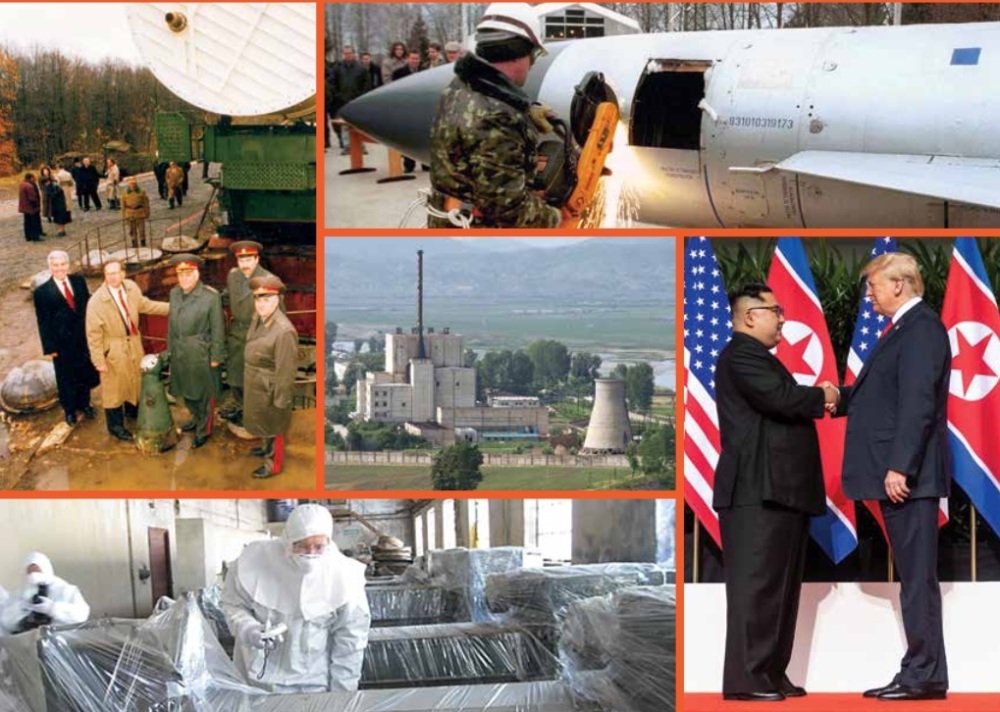
Kenley Butler
Research Associate, The James Martin Center for Nonproliferation Studies
At the June 2002 summit in Kananaskis, Canada, Group of Eight (G8) leaders issued a statement in which they agreed to commit up to $20 billion over 10 years to help Russia and other nations destroy their stockpiles of weapons of mass destruction. Under terms of the "G8 Global Partnership against the Spread of Weapons and Materials of Mass Destruction," informally known as "10 plus 10 over 10," the United States will provide up to half of this sum; Canada, the European Union, France, Germany, Italy, Japan, Russia, the United Kingdom and possibly others will contribute a matching amount.
G8 leaders adopted a set of six principles that outline broad goals for the initiative and nine guidelinesfor new projects. Under the guidelines, the Global Partnership will initiate new bilateral and multilateral projects and enhance existing ones, such as those under the long-standing U.S. Nunn-Lugar or Cooperative Threat Reduction Program. The G8 will establish a senior-level mechanism to coordinate Global Partnership activities, including monitoring progress and considering priorities. Russian President Putin agreed to provide contributing states the same privileges it accords the United States, namely access to sites, tax exemptions, and liability protection.
Months after the Summit, however, there is concern over the slow progress in collecting funding commitments from countries and still no coordinating mechanism or clear plan for moving forward. The G8 leaders agreed to review progress of the initiative at the June 2003 G8 summit in France.
Under the G8 "Global Partnership Against the Spread of Weapons and Material of Mass Destruction" (informally known as "10 + 10 over 10"), G8 leaders agreed to raise up to $20 billion for projects pertaining to disarmament, nonproliferation, counterterrorism, and nuclear safety over the next 10 years. The United States intends to provide half of the total funding.
The Global Partnership came out of a desire to prevent terrorists from acquiring weapons of mass destruction. In their official statement, G8 leaders committed themselves to "prevent terrorists, or those that harbor them, from acquiring or developing nuclear, chemical, radiological, and biological weapons; missiles; and related materials, equipment, and technology."
Specifically, the G8 adopted—and invited other countries to also adopt—six principles. In summary, these are to: (1) promote multilateral treaties that help prevent the spread of weapons, materials, and know-how; (2) account for and secure these items; (3) promote physical protection of facilities; (4) help detect, deter, and interdict illicit trafficking; (5) promote national export and transshipment controls; and (6) manage and dispose of nuclear, biological, and chemical weapons materials.
President Putin agreed to grant contributor countries the same rights it currently grants U.S. programs. The G8 leaders, including Russian President Putin, agreed to nine guidelines, which outline elements that must be present in each Global Partnership agreement. Among other things, the guidelines state that recipient countries must provide donor countries with access to sites, liability protection, and exemption from duties and taxes.
The G8 Global Partnership is intended to build on and expand programs such as those under the Cooperative Threat Reduction (CTR) Program. Since 1992, the United States has allocated $7 billion for CTR programs in Russia and other former Soviet states. These programs have focused on the following:
During that same period, G7 members contributed less than $1 billion for such programs. The United States has pressed allies to provide support for nonproliferation issues in the former Soviet Union since Nunn-Lugar was launched in 1992.[1] The Global Partnership attempts to leverage funds that the United States is already committing into a much larger sum.
Although the guidelines adopted by the G8 leaders at Kananaskis indicate the G8 will work in partnership, bilaterally, and multilaterally, U.S. officials have indicated that members will fund and implement projects of their choosing on a bilateral basis under government-to-government agreements with recipient countries. According to U.S. officials, there is no intention of establishing a Global Partnership multilateral implementation mechanism or common fund.[1]
The G8 Senior Officials will act as the coordinating mechanism to address priorities and identify program gaps to prevent duplication and overlap. U.S. officials hope to have a reporting mechanism in place by the end of calendar year 2002 for countries to report exactly which programs are involved.[1] The mechanism will need to be flexible enough to take into account the various budgeting procedures and fiscal years of participating countries.
In its June 2002 statement, the G8 specifically listed its top priorities as the following:
The Russian Federation identified chemical weapons destruction and general-purpose submarine dismantlement as program priorities. Some nations expressed interest in assisting with the security of nuclear material and the physical protection of strategic nuclear warheads [5]. The Nordic nations, should they join the Partnership, might have an interest in continuing current programs to avert environmental damage that might be caused by rusting nuclear submarines in the Arctic. The strengths and interests of the participating countries will be complimentary; the United States, for example, does not have a legal mandate to engage in environmental projects, while others have considerable experience in this area.
Because of its long history of involvement in CTR programs in the former Soviet Union, the United States will likely have a significant role in shaping Partnership priorities.[2] The United States has provided information on its programs and has identified projects where substantial resources are needed from other countries. Though there is not yet an official list of projects the United States considers top priority, a list compiled by Senator Lugar (R-Indiana) includes the following projects:
According to the guidelines adopted at Kananaskis, funds disbursed or released after the June 2002 announcement will be included in the total committed resources.
The Bush administration's FY2003 request for nonproliferation programs in the former Soviet Union is approximately $1 billion. President Bush has indicated that the United States will maintain this level of effort for a ten-year period. As of October 2002, about $15 billion of the $20 billion total had been committed (see Funding table below). In his October 9, 2002 testimony to the Senate Foreign Relations Committee, Undersecretary of State for Arms Control and International Security John Bolton indicated that some countries have not yet publicly announced pledges.
The June 2002 statement by G8 leaders specified that "a range of financing options, including the option of bilateral debt for program exchanges, will be available to countries that contribute to this Global Partnership." A portion of Russia's debt to participating countries would be forgiven. In exchange, Russia would deposit funds in Russian currency into an account dedicated to carrying out specified nonproliferation activities.[4] On September 30, 2002, President Bush signed into law the State Department Authorization bill that includes debt swap for nonproliferation provisions. Through the swaps, the U.S. Treasury Department will restructure up to $300 million in FY02 and FY03 of Russia's Soviet-era debt to the United States.
While the United States intends to pursue debt swap as a means of financing nonproliferation projects in Russia, other G8 members are less supportive of the option. Italy and France have reportedly expressed an interest in debt swap; Canada, the United Kingdom, and Japan have not taken a stand; and Germany has reportedly committed new money to avoid debt swap initiatives altogether. There is concern in Russia that debt swap initiatives could spur inflation or hurt the country's international credit rating, though no official Russian pronouncement on whether Russia would be willing to engage in such initiatives has been made.[5]
As of November 2002, experts have raised questions about the seriousness of the pledges and noted that progress to date has been minimal. Even on the U.S. side, G8 efforts have been moving slowly. As recently as October 31, 2002, Stephen Younger, director of the U.S. Defense Threat Reduction Agency, which oversees many of the CTR activities, had yet to be asked to play a role in coordinating the U.S. G8 effort.[6]
G8 Senior Officials met September 26-27, 2002 in Ottawa to discuss implementation of 10 plus 10 over 10, including the establishment of interagency coordination mechanisms within countries, identification of potential projects, and the budgeting of resources.[1] Another meeting is planned before the end of calendar year 2002. In 2003 the G8 will be lead by France, whose president promises that "all necessary impetus will be given to put this program to work."[7] Progress on the Global Partnership will be reviewed at the June 2003 G8 summit in France.
Many issues remain unresolved, including the following:
The June 2002 establishment of the Global Partnership was a step in the right direction. The Partnership will only be successful, however, if G8 and elected leaders are able to successfully and quickly resolve these unresolved issues and turn commitments into action.
[1] Testimony of John R. Bolton, Undersecretary of State for Arms Control and International Security, Senate Foreign Relations Committee Hearing on Reducing Nuclear Threat from Russia, October 9, 2002, U.S. State Department, www.state.gov.
[2] Richard Lugar, Senate Foreign Relations Committee Hearing on Reducing Nuclear Threat from Russia, October 9, 2002.
[3] Richard G. Lugar, "The Next Steps in U.S. Nonproliferation Policy," Arms Control Today, December 2002, Arms Control Association, www.armscontrol.org.
[4] "Implementing a Debt Reduction-For-Nonproliferation Program with Russia: Re-directing Debt Repayment to Fund Crucial Non-Proliferation Priorities," The Justice Project, www.justice.policy.net.
[5] Testimony of Kenneth N. Luongo, Executive Director of the Russian-American Nuclear Security Advisory Council, Senate Foreign Relations Committee Hearing on Reducing Nuclear Threat from Russia, October 9, 2002, RANSAC, www.ransac.org.
[6] Bryan Bender, "U.S. Response: Abraham Outlines 10 Principles for Nuclear, Radiological Security," Global Security Newswire, November 15, 2002, Nuclear Threat Initiative, www.nti.org.
[7] Statement by President Chirac, August 29, 2002, www.diplomatie.gov.
Sign up for our newsletter to get the latest on nuclear and biological threats.
Libya's decision to renounce its WMD programs, a resounding success for the nonproliferation regime. (CNS)
The weapons of mass destruction (WMD) nonproliferation and disarmament activities in Central Asia in the decade following the end of the Cold War. (CNS)
The Korean Peninsula is one of the most volatile and heavily militarized places in the world, carrying tremendous risk of conflict and the potential for catastrophic nuclear exchange.
